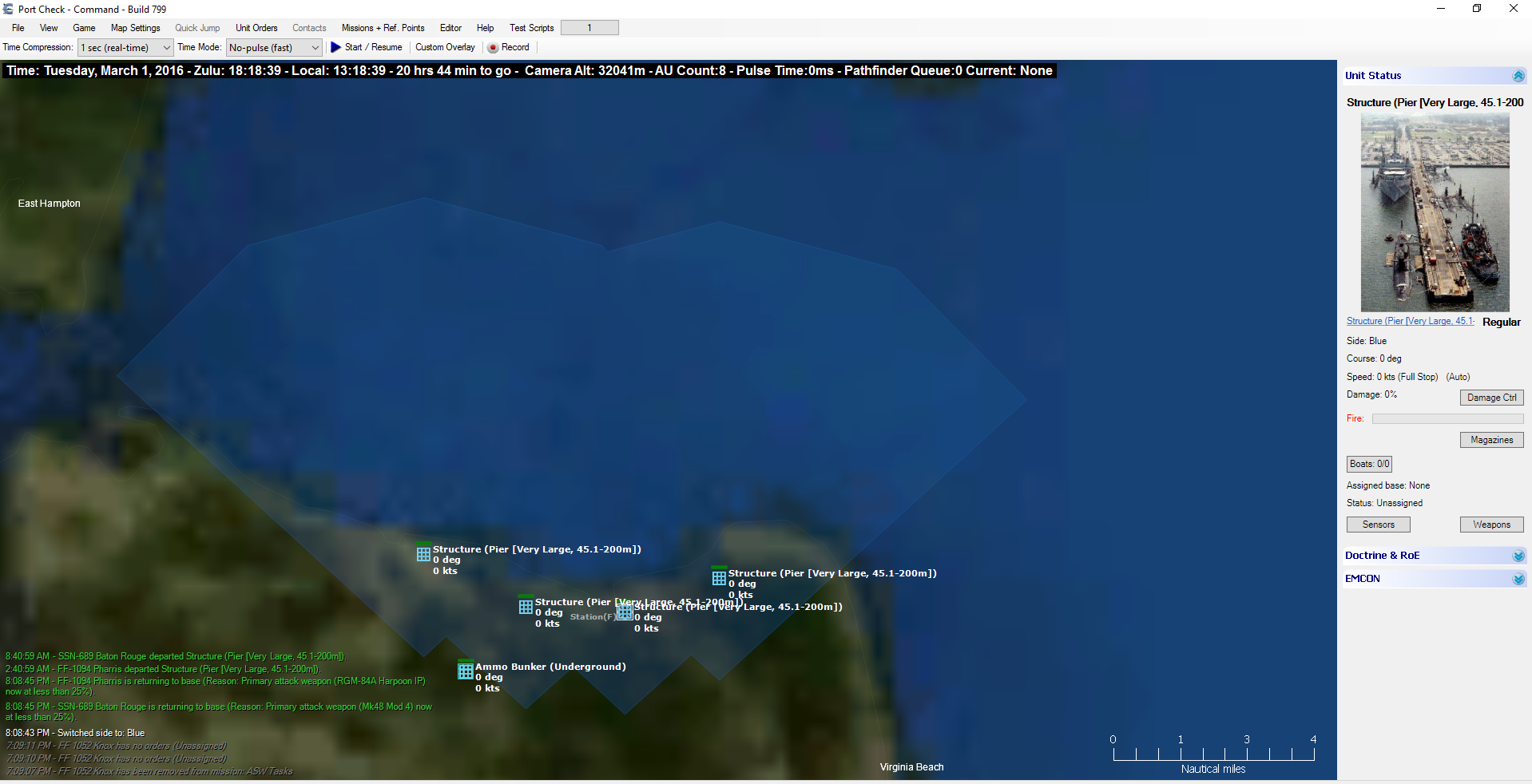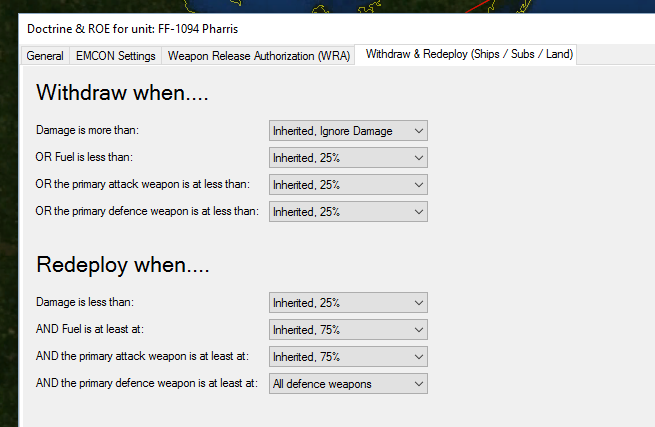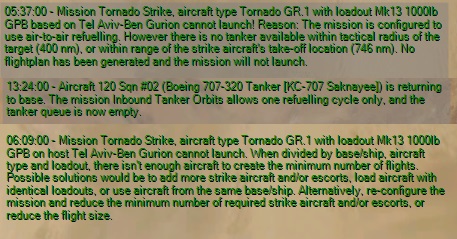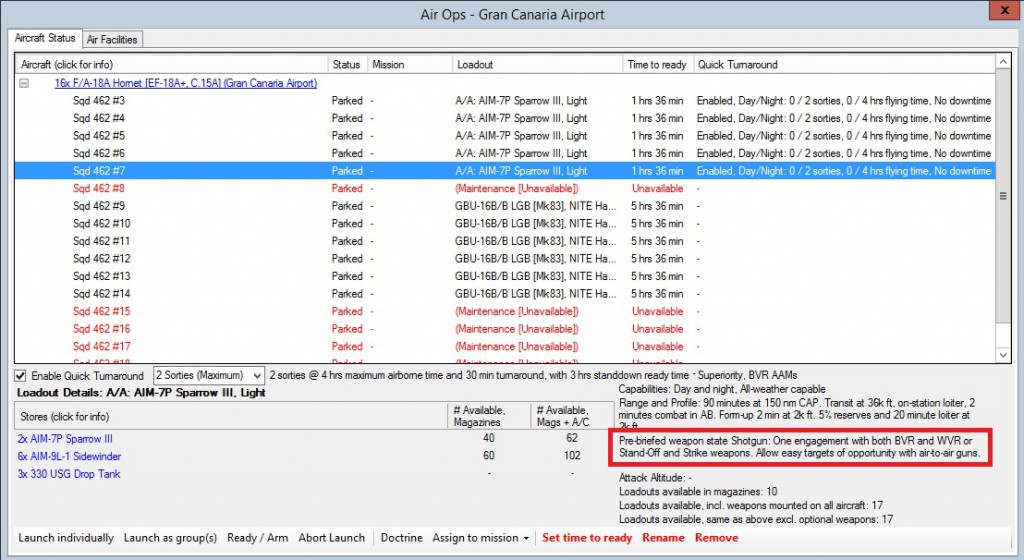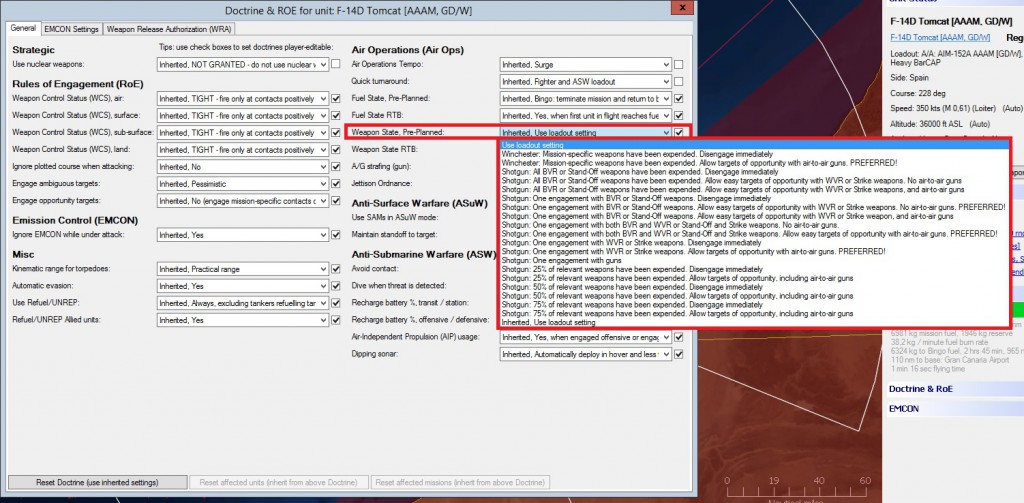The great leaps of v1.11: Pier operations
 The v1.10 update for CMANO was released on Feb 26 to widespread acclaim. The dev team is already hard at work preparing the next upcoming major release, version v1.11. After the panoply of new features in past updates, what new tricks do the CMANO devs have up their sleeves? Let’s take a peek.
The v1.10 update for CMANO was released on Feb 26 to widespread acclaim. The dev team is already hard at work preparing the next upcoming major release, version v1.11. After the panoply of new features in past updates, what new tricks do the CMANO devs have up their sleeves? Let’s take a peek.
Pier Operations
You asked for it, so here it is!
Ships have had the ability to dock with designated parent ships and facilities ever since the beta days of Command, but their ability to be serviced while docked was very limited. This changes with v1.11: Proper refuel, re-arm and repairs are implemented.
Pier facilities now extend passable “pier lane” areas around them that allow ships to navigate to pier areas even slightly inland (similar to canals). This allows true-to-life positioning of pier facilities without having to flatten the terrain data around them in order to make them accessible.
The light-shadow polygon is the “pier lane” area projected by the multiple pier facilities inland. Ships and submarines can freely traverse this area (even though terrain is nominally present) to navigate in and out of the piers.
Once a ship docks to a pier (or parent ship), the process of refuel, repair and replenishment begins. Both refueling and rearming happen at faster rates than on UNREP hookups as the docking condition allows for a stabler environment and more extended facilities and tooling. In addition, while a ship underway can perform repairs only to minor component damage and cannot repair structural damage, docked units can perform repairs on medium- and heavily-damaged systems, and can also repair their structures.
Replenishment rates have been given a thorough overhaul in v1.11, both for pierside and UNREP modes. Light weapons can be loaded quite fast as before, but heavier weapons (particularly heavy gun shells or large bombs, missiles or rockets) can take hours to transfer and load.
Readying a ship for redeployment differs from aircraft turnaround in a number of ways. Ship preparation typically takes far longer than aircraft (except for very small boats), and in contrast to an aircraft, a ship is perfectly able to put to sea again while still in far from optimal condition. Accordingly, the player can order one or more ships to redeploy while they still have damage, or miss weapons and fuel.
This sounds simple enough for manual control, but what about AI control? How do AI-controlled ships decide when to disengage from frontline operations and when it makes sense to stop repairs etc. and re-deploy? To enable the AI to make reasonable decisions, a new set of doctrine settings (Withdraw / Redeploy criteria) are added:
The status of each of those aspects is continuously tracked and evaluated against the doctrine threshold and a ship will withdraw from its mission if any of the withdrawal criteria are reached. Conversely, while docked, these criteria are regularly checked and a ship is allowed (by the AI) to re-sortie only if everything is “green across the board”. The player of course can still order nay ship to sail immediately regardless of its condition.
These new settings allow tailoring the withdraw and redeploy behavior of a ship to its unique strengths / weaknesses as well as to the needs of her mission tasking. For example an anti-aircraft escort may be set to ignore depletion of its offensive weapons, fuel and any damages to itself and withdraw from the line only when its defensive (AAW) armament is depleted. Conversely, a sensitive high-value unit may be configured to withdraw immediately on the first scratch of damage.

Busy day at Norfolk. Both the frigate and the fast attack sub are fine on damage and fuel, but both are short on ammo. Will you wait for them to re-arm (which may take a while!) or flush them out to sea immediately? Choices, choices…
The redeployment criteria allow the player (or scenario author) to make his own decisions on how “ready” he wants his ships to put out to sea again: Does he wait until every last bit of ammo is restocked? Is it enough to repair damage and get refueled? Remember, while your ships are in port they are not out to sea and the enemy gets a free pass. Obviously there is no single “best” answer, and the theater/operational exigencies (as well as time pressure) are likely to force the player to make decisions that he is not entirely happy with. Real-life ops are very often a compromise, and Command reflects this.
The implementation of pier ops in Command, even in its “raw”, unpolished form in v1.11, is a huge step forward in expanding the scope of the game into the theater/strategic scale. Numerous players have asked for the ability to fight out to air and sea, then get their forces back in port and repair/ready them as possible, and get out there to fight again. v1.11 is the answer to their prayers. We hope implementing this along with our substantial lua scripting and event editor features will encourage editor’s and players to explore longer duration scenarios.
The great leaps of v1.11: AGL altitude settings, stores jettison and mission player feedback
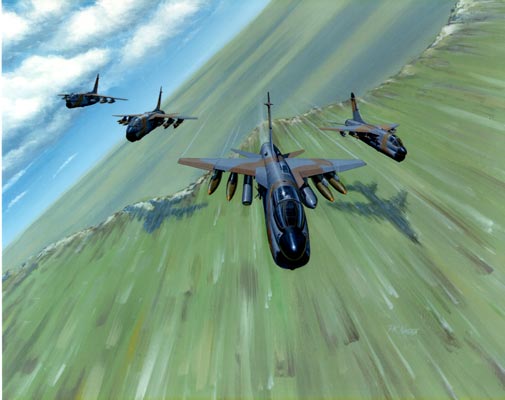 The v1.10 update for CMANO was released on Feb 26 to widespread acclaim. The dev team is already hard at work preparing the next upcoming major release, version v1.11. After the panoply of new features in past updates, what new tricks do the CMANO devs have up their sleeves? Let’s take a peek.
The v1.10 update for CMANO was released on Feb 26 to widespread acclaim. The dev team is already hard at work preparing the next upcoming major release, version v1.11. After the panoply of new features in past updates, what new tricks do the CMANO devs have up their sleeves? Let’s take a peek.
Above Ground Level (AGL) altitude settings
Further preparations have been made for the startup of the Advanced Strike Planner project. Command v1.11 adds an Above Ground Level (AGL) altitude setting, in addition to the existing Above Sea Level (ASL) setting, to enable terrain-following (i.e. ride altitude) for aircraft equipped with terrain-following and terrain-avoidance radar. Currently, this distinction is only made in the Speed/Altitude window but it will be a important feature in the Advanced Strike Planner.
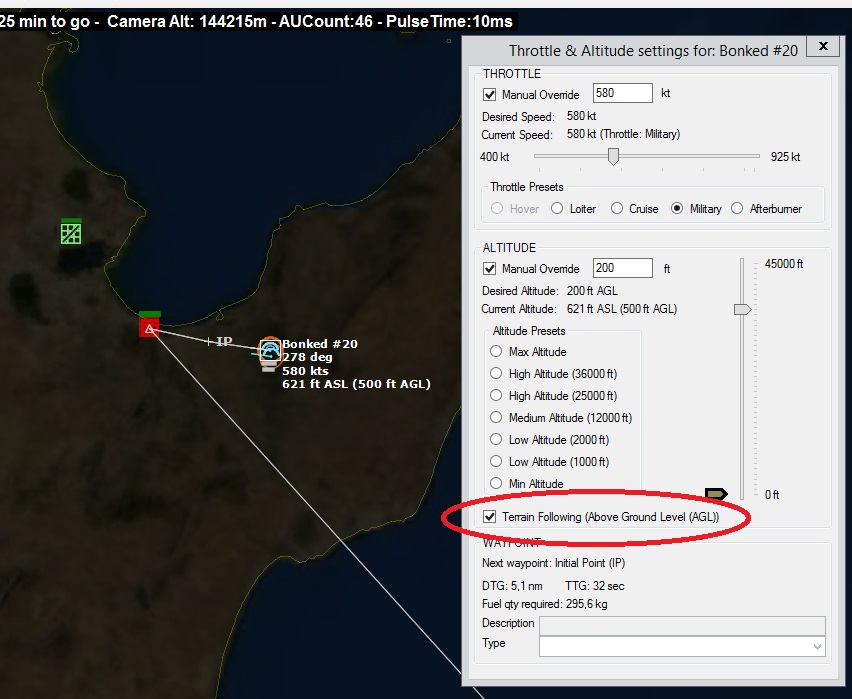 (Click on image for full view)
(Click on image for full view)
In addition, all weapons have had their weapon release parameters updated in database v441. The minimum and maximum release altitudes may be AGL or ASL, or both. For example, the firing parameters could require the aircraft to fly at minimum 1000ft above sea level (ASL) and also have minimum 200ft ground clearance (AGL).
Stores Jettison
This has been a popular user request and especially after we introduced the weight-dependent aircraft performance tweaks in v1.10. Aircraft will now jettison their A2G stores when evading an attack (if the relevant doctrine setting is set to YES). This is accompanied by a relevant message detailing the stores ejected.
The jettison check is made every 5 seconds (it takes a few seconds to do this in the cockpit), so there is a chance that an aircraft that is caught by surprise will have no time to jettison its stores before the missile impact happens. Also only external stores can be jettisoned (we have no knowledge of internal stores being ejected in combat).
The current implementation has a known issue: Conformal Fuel Tanks (CFTs), like those on the F-15E and numerous export F-16s, are treated like drop tanks and thus jettisoned (in RL they cannot be ejected). We plan to address this in the future.
Mission player feedback: “Why aren’t my strike aircraft taking off!?”
Mission Editor 2.0 introduced in Command v1.07 was a significant step forward in mission planning capabilities. However, many users felt that the built-in flightplan generator wasn’t too forthcoming with the reasons why a mission would refuse to launch. Is the target out of range? Have we run out of aircraft or targets? Is it due to a lack tankers? Something else?
Command v1.11 solves this by giving a lot more feedback. If a strike mission fails to launch it will tell the player the exact reason, and in most cases also give advice on how to solve the problem. So keep an eye on the message log, and you may see something like this:
The great leaps of v1.11: Massive refuelling improvements
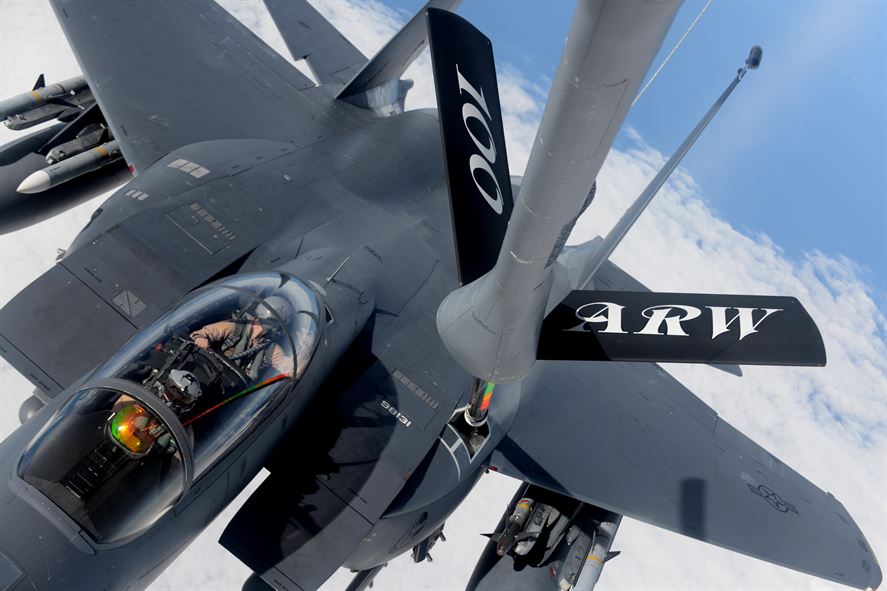 The v1.10 update for CMANO was released on Feb 26 to widespread acclaim. The dev team is already hard at work preparing the next upcoming major release, version v1.11. After the panoply of new features in past updates, what new tricks do the CMANO devs have up their sleeves? Let’s take a peek.
The v1.10 update for CMANO was released on Feb 26 to widespread acclaim. The dev team is already hard at work preparing the next upcoming major release, version v1.11. After the panoply of new features in past updates, what new tricks do the CMANO devs have up their sleeves? Let’s take a peek.
Massive Air-to-Air Refueling (A2AR) improvements
Air-to-air refueling (A2AR) has been given a complete overhaul. There are significant improvements to the AI’s decision making processes and it is a lot smarter about when and where to refuel. Furthermore, the player is given the ability to manually select which tanker(s) to refuel from, and there are additional options in the Mission Editor to control tanker usage. Tankers will also tell the player which receivers are currently queued for refueling, and display the number of aircraft served thus far. Further super-specialized A2AR improvements are planned for integration into the Advanced Strike Planner, such as ‘refuelling waypoints’, but we believe the current tanker functionality will satisfy 99% of Command players’ needs.
Many players have told us the thing they have missed the most is the ability to manually select which tanker their aircraft should refuel from. You now have three choices:
– Automatic, which is the same behavior as earlier, i.e. the AI picks the most suitable tanker based on remaining fuel and shortest rendezvous time.
– Manual, simply click on the tanker you want to refuel from.
– From mission, pick the most suitable tanker from the tankers assigned to the specified support or ferry mission.
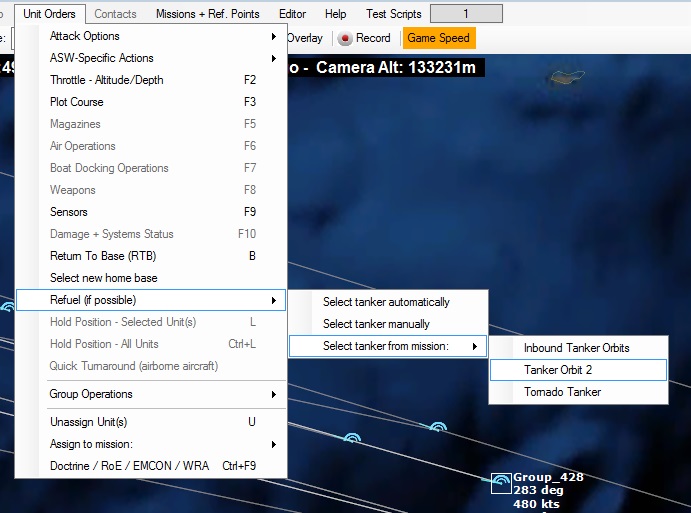 (Click on image for full view)
(Click on image for full view)
The improved Mission Editor has several new settings for configuring tanker usage. A new window called the ‘Tanker Planner’ allows the player to set the conditions for when tanking should be attempted when the aircraft are in the air, and also set launch conditions for the mission itself. The parameters are as follows:
Use nearest tanker with enough fuel to serve receivers: Airborne receivers assigned to this mission will pick the most suitable tanker based on remaining offloadable fuel and shortest rendezvous time.
Use tankers assigned to specific missions: Limit the tanker pick to those assigned to given missions only. When combined with the new mission Startup and Termination functionality along with the Support Mission ‘One refueling cycle’ and ‘Number of receivers’ limitations (explained below), the player now has the ability to do pretty detailed tanker planning.
Mission planning details – Minimum number of tankers needed: Specify the minimum number of tankers needed to launch this mission. In some cases, especially for larger air strikes, you may need a minimum amount of fuel (2,000,000 lb, hah!) and this setting allows you to postpone strike missions if the tanker requirements cannot be met.
Mission planning details – Minimum number of tankers airborne: Same as above, but specifies the minimum number of tankers that have to be in the air rather than just available.
Mission planning details – Minimum number of tankers on station: This is a further refinement of the above settings and specifies the number of tankers that must be on-station. It only applies to tankers assigned to support missions. Ferry missions are ignored.
Mission planning details – Launch mission without tankers in place (Extremely risky!): The description says it all. In some cases it is desirable to launch a mission without having tankers within tactical radius of the target. Especially in high-threat environments. This setting allows the player to override all built-in safety measures and just launch the strike aircraft regardless of tanker availability at the moment. The aircraft will of course attempt to refuel when airborne, however on the ingress leg they will only attempt to hook up with tankers ahead of them, not behind. Thus it is up to the player or scenario designer to make sure tankers get into position before the receivers run out of fuel and crash. (Dev note: on the return leg, strike aircraft will also look for tankers behind them so the requirements are not so strict there).
Mission execution details – Maximum number of receivers in queue per tanker: In order to prevent one tanker from accepting too many receivers, the player can specify the maximum number of aircraft to send to each tanker.
Mission execution details – Receivers start looking for tankers when down to X percent of mission fuel: By default, strike aircraft will start looking for tankers when down to 85 percent of mission fuel, and aircraft on patrol missions will attempt to refuel when reaching 60 percent. This works well in most cases. However, sometimes it is desirable to delay the search for tankers, and this is a super-nerdy way of doing just that. The setting works for all mission types including Ferry missions. A prettier way to do it is to use the setting below:
Airborne receivers can book tankers within…: When aircraft are down to the fuel percentage specified above, they start looking for tankers. The default is to pick a tanker within the receiver’s tactical range (i.e. strike radius multiplied by two, minus fuel already burned), but the player can also decide that aircraft should only look for tankers within a certain radius.
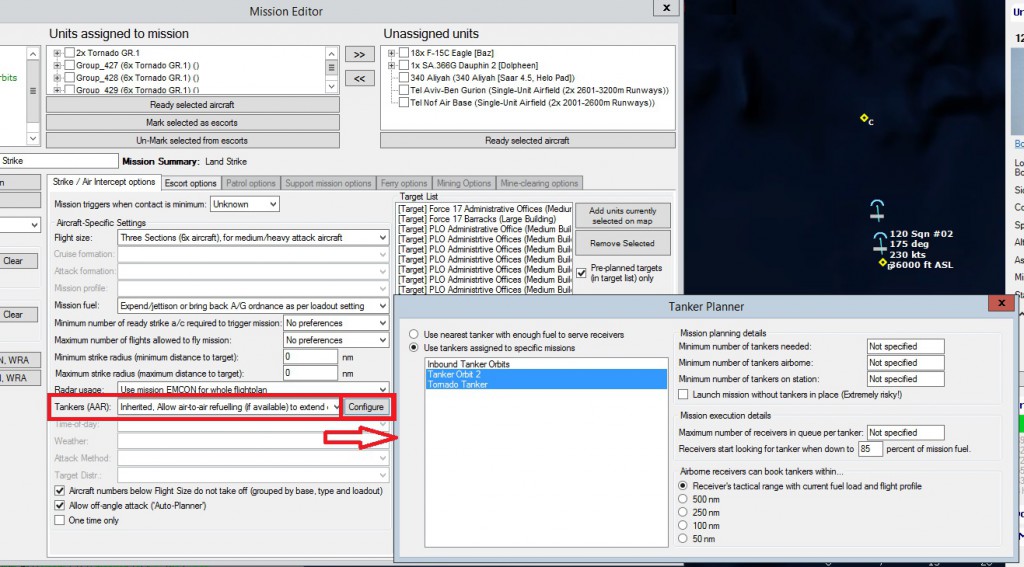 (Click on image for full view)
(Click on image for full view)
It is our experience that most players use Support Missions for tanker stations. In order to improve tanker ops flexibility and realism, Command v1.11 adds user-configurable mission termination time (in addition to mission activation time found in earlier versions of the simulator). This allows the player to minimize the tankers’ exposure to threats by de-activating the mission and force them to go home. In addition, the updated Mission Editor adds the ability to make tankers return to base when they have conducted one refueling cycle, or when a specified number of receivers have been served:
Tankers return to base after one refueling cycle, when queue is empty: Tankers will remain on-station for as long as there are receivers in the tanker’s receiver queue. The tankers will accept refueling requests from additional receivers for as long as there is enough fuel, and once all aircraft in the queue have been served the tankers will return to base. This ensures the tankers will only stay on station for as long as they are needed.
Tankers can refuel maximum X receivers, rounded up to nearest flight: Tankers will serve a limited number of receivers. This is especially useful when each tanker carries limited amount of fuel, e.g. when using buddy refueling or when refueling strategic bombers. The number is rounded upwards to the nearest flight. I.e. if the maximum number is six receivers, the tanker will accept two flights of four receivers each. This option can be used in combination with the above setting to create very flexible mission termination conditions.
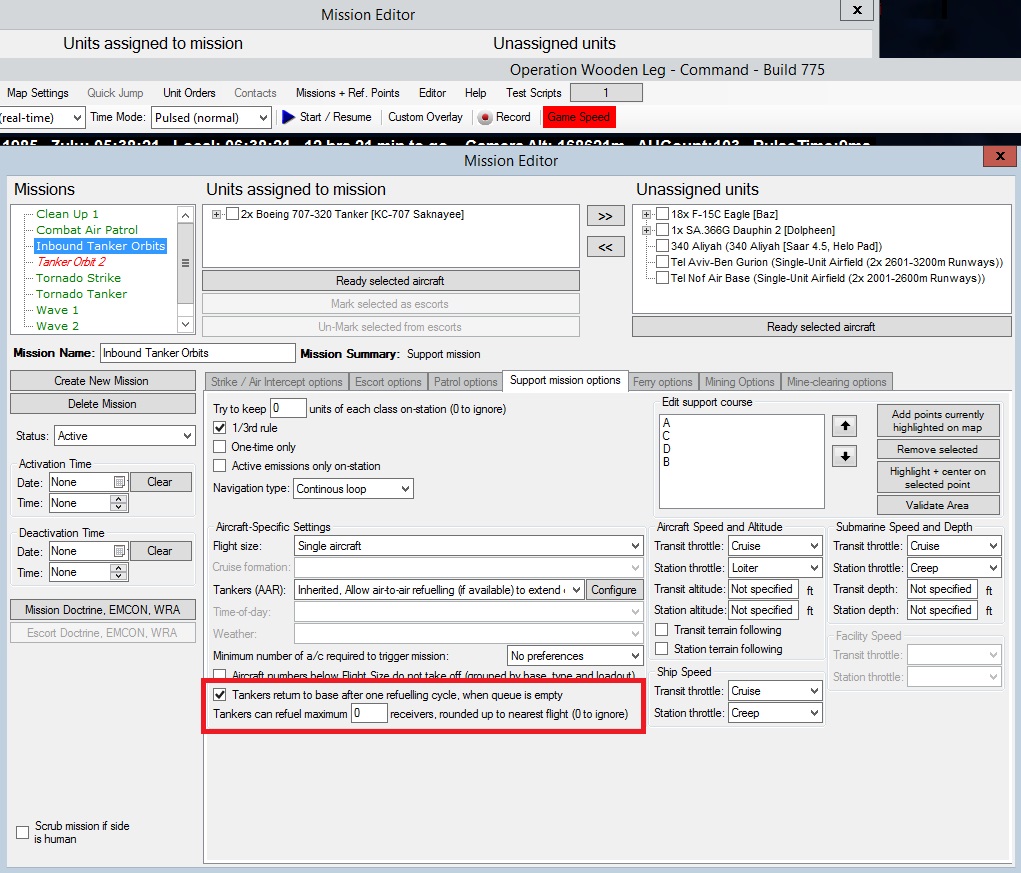 (Click on image for full view)
(Click on image for full view)
The great leaps of v1.11: Winchester, Shotgun, Bingo, Joker and Chicken
 The v1.10 update for CMANO was released on Feb 26 to widespread acclaim. The dev team is already hard at work preparing the next upcoming major release, version v1.11. After the panoply of new features in past updates, what new tricks do the CMANO devs have up their sleeves? Let’s find out.
The v1.10 update for CMANO was released on Feb 26 to widespread acclaim. The dev team is already hard at work preparing the next upcoming major release, version v1.11. After the panoply of new features in past updates, what new tricks do the CMANO devs have up their sleeves? Let’s find out.
Winchester, Shotgun, Bingo, Joker and Chicken
Winchester and Bingo are well-known brevity calls for “no ordnance remaining” and “low fuel state” respectively. However, in many situations it would make sense for aircraft to begin separation well before they are completely out of weapons or flying on fumes. Command v1.11 adds player-customizable “Shotgun” weapon state and “Joker” fuel state, and even includes the “Chicken” fuel state for emergencies. A quick intro to these terms can be found in the Multiservice tactical brevity code article on Wikipedia and in the Command Mega-FAQ.
All aircraft loadouts now have their own pre-defined Winchester or Shotgun weapon states. The default states depend on loadout role and weapon types, which vary from all-Sidewinder F-16 air superiority loadouts to MiG-31 long-range one-pass intercept loadouts.
In some cases the player may not want to use the pre-defined Winchester or Shotgun settings stored in the database. For instance, a loadout may allow an aircraft to bore in on and engage hostiles with guns. However that may not be desirable in many situations. Therefore, the player can decide to override the default settings through the Doctrine window. Weapon states are inherited like all other Doctrine settings, and can therefore be configured per unit, per group, per mission and/or per side.
There are approximately twenty different Winchester and Shotgun settings to choose from. The first two are normal Winchester weapon states while the remainder are Shotgun setups that allow aircraft to disengage when it is most advantageous to do so. It should be noted that Shotgun states are split into two main categories: those where aircraft will start separation when certain types or quantities of ordnance has been expended, and those that will make aircraft disengage after the engagement is over. The latter is usually preferred, as the aircraft will continue fighting until the enemy has been defeated or the weapon state has been reached, whatever comes first. This means aircraft may go home with weapons left onboard, and will not hang around after an engagement is over, low on fuel and ordnance, and risk getting ambushed by flights of ‘fresh’ bogies. Past experience shows that the latter settings significantly reduces losses to own forces and has also made the AI a tougher opponent.
The user-selectable Winchester and Shotgun doctrine settings are:
- Use loadout setting – Uses default weapon state settings from the database, tailored to each loadout’s role and ordnance.
- Winchester: Mission-specific weapons have been expended. Disengage immediately – The traditional pain vanilla Winchester weapon state.
- Winchester: Mission-specific weapons have been expended. Allow targets of opportunity with air-to-air guns – Same as above, but engage nearby bogies with guns after we’re out of missiles. Applies to air-to-air missile loadouts only. For guns-only air-to-air loadouts and all air-to-ground loadouts the behaviour is the same as above.
- Shotgun: All BVR or Stand-Off weapons have been expended. Disengage immediately – Disengage after firing all Beyond Visual Range (BVR, air-to-air) or Stand-Off (SO, air-to-ground) weapons. This is a risky option as your fighter aircraft may only have one medium-range air-to-air missile (AAM) left and then decide to engage ‘fresh’ flights of bandits. Use with caution!
- Shotgun: All BVR or Stand-Off weapons have been expended. Allow easy targets of opportunity with WVR or Strike weapons. No air-to-air guns – Same as above, but if easy targets or threats are nearby then shoot at them with remaining Within Visual Range (WVR, air-to-air) or SR (Short-Range, air-to-ground) weapons before disengaging. A target has to be within 120% of the WVR/SR weapons’ range to be engaged. Otherwise, the aircraft will turn, go to afterburner, and try to leave the area at max speed.
- Shotgun: All BVR or Stand-Off weapons have been expended. Allow easy targets of opportunity with WVR or Strike weapons, and air-to-air guns – Same as above, but also engage bogies with guns if given an easy chance. Typically, a target has to be within 5nm and closing to be of any interest. Applies to air-to-air (A/A) loadouts only. For air-to-ground (A/G) loadouts the behaviour is the same as above.
- Shotgun: One engagement with BVR or Stand-Off weapons. Disengage immediately – Attempt one engagement with BVR or SO weapons. Continue fighting for as long as there are targets within easy reach and then disengage. This is a safe option as it ensures aircraft do not ‘hang around’ after they have expended their most potent weapons, and thus avoid becoming easy targets if engaged by ‘fresh’ enemy units.
- Shotgun: One engagement with BVR or Stand-Off weapons. Allow easy targets of opportunity with WVR or Strike weapons. No air-to-air guns – Same as above, but if easy targets or threats are nearby, shoot at them with remaining WVR or Short-Range weapons before disengaging. A target is considered ‘easy’ when within 120% of the remaining WVR or Strike weapon’s maximum range (minimum 5nm). In other words, the fighter won’t spend much energy chasing down a bogey after the Shotgun weapon state has been reached, and will leave the target area as quickly as possible.
- Shotgun: One engagement with BVR or Stand-Off weapons. Allow easy targets of opportunity with WVR or Strike weapon, and air-to-air guns – Same as above, but also engage bogies with guns. Applies to air-to-air (A/A) loadouts only. For air-to-ground (A/G) loadouts the behaviour is the same as above.
- Shotgun: One engagement with both BVR and WVR or Stand-Off and Strike weapons. No air-to-air guns – Make one engagement with BVR and WVR, or SO and Strike Weapons. Do not disengage when out of BVR or SO weapons, but continue the engagement with WVR weapons.
- Shotgun: One engagement with both BVR and WVR or Stand-Off and Strike weapons. Allow easy targets of opportunity with air-to-air guns – Follows the above logics.
- Shotgun: One engagement with WVR or Strike weapons. Disengage immediately – Make one engagement with WVR or SR weapons. Continue fighting for as long as there are targets within easy reach and then disengage.
- Shotgun: One engagement with WVR or Strike weapons. Allow targets of opportunity with air-to-air guns – Same as above but also engage bogies with guns. Applies to air-to-air (A/A) loadouts only. For air-to-ground (A/G) loadouts, the behaviour is the same as above.
- Shotgun: One engagement with guns – Make one engagement with guns. Continue fighting for as long as there are targets nearby and then disengage.
- Shotgun: 25% of relevant weapons have been expended. Disengage immediately – Disengage after 1/4 of mission-specific weapons have been expended.
- Shotgun: 25% of relevant weapons have been expended. Allow targets of opportunity, including air-to-air guns – Same as above, but if easy targets or threats are nearby then shoot at those too. Also engage bogies with guns (applies to air-to-air (A/A) loadouts only).
- Shotgun: 50% of relevant weapons have been expended. Disengage immediately – Disengage after half of mission-specific weapons have been expended.
- Shotgun: 50% of relevant weapons have been expended. Allow targets of opportunity, including air-to-air guns – Same as above, but if easy targets or threats are nearby then shoot at those too. Also engage bogies with guns (applies to air-to-air (A/A) loadouts only).
- Shotgun: 75% of relevant weapons have been expended. Disengage immediately – Disengage after 3/4 of mission-specific weapons have been expended.
- Shotgun: 75% of relevant weapons have been expended. Allow targets of opportunity, including air-to-air guns – Same as above, but if easy targets or threats are nearby then shoot at those too. Also engage bogies with guns (applies to air-to-air (A/A) loadouts only).
The Joker fuel state can be set as a percentage of mission fuel, which is max fuel minus reserves. If an aircraft carries 10 000kg of fuel, reserves is typically 10%, which means mission fuel is 9000kg. If the player wants an aircraft to land with 40% mission fuel remaining (3600kg + 1000kg reserve), simply select ‘Joker: 40% above Bingo’.
In addition to setting the weapon and fuel state conditions, the player may also choose what shall happen when said state is reached. Shall a flight of fighters Return To Base (RTB) when the first aircraft reaches the fuel/weapon state? Last aircraft? Or shall the aircraft disengage and leave their wingmen behind as they run out of weapons and fuel? Or should they not RTB at all? The player now has full control – and responsibility.
CMANO official updates
Since its initial release, Command has enjoyed a series of significant free updates provided by the WarfareSims development team. In order of release these are :
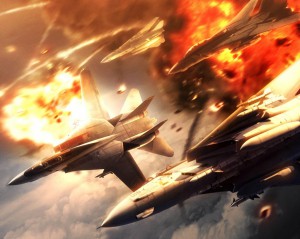 v1.01, released on October 9, 2013, was a quick-fix update to resolve issues discovered during late beta or just after the v1.00 release, and incorporate early customer feedback. Its main new features were:
v1.01, released on October 9, 2013, was a quick-fix update to resolve issues discovered during late beta or just after the v1.00 release, and incorporate early customer feedback. Its main new features were:
- Significant performance increase, both for UI (map zoom/pan) and sim-core execution (which in turn means even better scalability). Also the high-fidelity mode (0.1 sec pulse in realtime) is now optional instead of mandatory so Command runs great even on low-spec machines – and screams on capable rigs.
- UI enhancements: Option to zoom at mouse location, option to ghost/hide sonobuoys, ability to quickly de-select all reference points, ability to abort aircraft launches, ability to order hold-fire on multiple selected units/groups.
- DB viewer enhancements: Dedicated weapon page, various improvements on existing pages.
- Scen Editor improvements, e.g. the “Add Unit” window remembers its last used filters (much fewer clicks needed).
- Simulation mechanics improvements (refined dive rates, helmet-mounted sights, semi-active SAMs in anti-surface mode etc.)
- Four scenarios previously available separately (community downloads) were integrated on the standard release: Brother against Brother, Canary’s Cage, Choking Halifax and Fighter Weapons School – GAT 5&6.
 v1.02, released on December 19, 2013, was the first comprehensive update. Its main features were:
v1.02, released on December 19, 2013, was the first comprehensive update. Its main features were:
- Significant improvements on performance, scalability and stability.
- Improved user interface (UI) with lots of new features, fixes & changes in every aspect (map, unit control, DB viewer etc.) straight from user feedback
- Improvements to the scenario editor & mission editor
- More configurable realism options (e.g. unlimited aircraft weapons at bases) for users who want to quickly experiment
- Improved simulation realism with new features like variable crew proficiency (side-level only), improved sonar modeling, more AI & doctrine options and other additions & fixes
- Improved multimedia experience with new sound effects & optional background music.
 v1.03, released on March 21, 2014, focused on further improving performance and stability:
v1.03, released on March 21, 2014, focused on further improving performance and stability:
- Greatly improved game speed with the new no-pulse (aka “Turbo mode”) time mode.
- Improved stability with hundreds of crash/bug/logic-flaw fixes.
- Further realism features like realistic loadout drag & weight effect on fuel consumption (“Christmas tree” loadouts now have a price), enhanced weather effects and refined air-ops AI options.
- Countless database & installation additions – from WW2-era IJN aircraft and hypothetical Cold War units & weapons like the Yak-141, Ulyanovsk CVN, F-23 ATF, A-12 Avenger II, Super Tomcat 21 and “son of Phoenix” AIM-152 AAAM all the way to ultra-modern hardware like the MOP super bunker-buster, Club-K container-launched cruise missile, the UK’s Type-26 frigate, Russian Vityaz and Morfey SAMs and Chinese burgeoning air and naval forces.
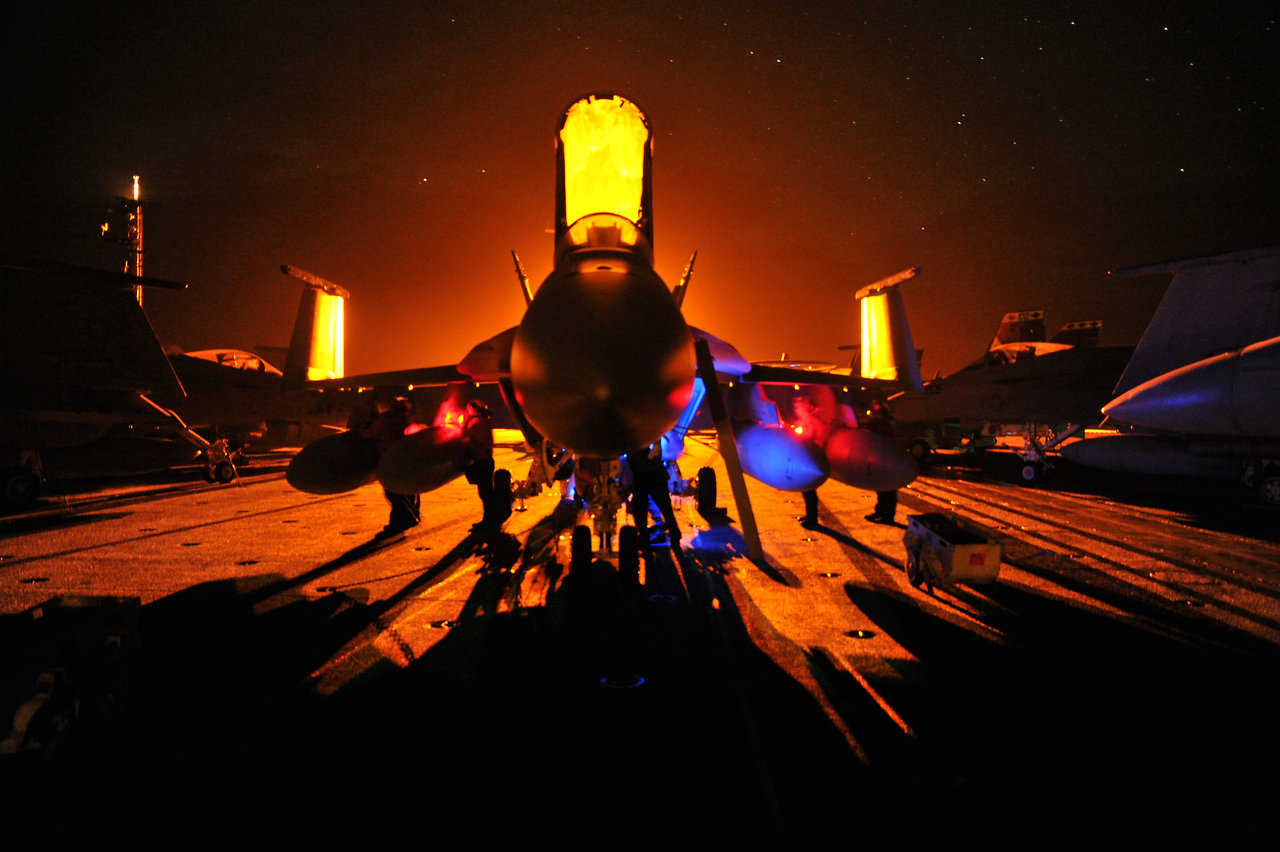 v1.04, released on July 9, 2014, further emphasized air operations by introducing the “strike auto-planner”, effectively a “light” version of the comprehensive strike planner currently under development which automatically plots sensible ingress & egress profiles for strike missions, thus providing a ready-to-modify template to the player. Other changes and additions were:
v1.04, released on July 9, 2014, further emphasized air operations by introducing the “strike auto-planner”, effectively a “light” version of the comprehensive strike planner currently under development which automatically plots sensible ingress & egress profiles for strike missions, thus providing a ready-to-modify template to the player. Other changes and additions were:
- An extensive array of UI enhancements such as wireframe-only map view, selection-only range symbols, new hotkeys, menu list for quick-jump slots, additional information on the database viewer, configurable ghosted-unit visibility, configurable plotted course visibility, one-click jump to unit mission, single-icon enemy groups and more.
- AI and mission editor additions such as configurable sprint-and-drift, optional prosecution areas for patrols (which significantly improved the AI’s ability to avoid hopeless long-range shots or fall victim to player draw-out ambushes), new doctrine options and more.
- Improved simulation mechanics such as multiple cloud conditions, refined offboard-sonar modelling, ABM/ASAT guidance refinements, realism improvements for anti-missile engagements, longer-range AI torpedo shots and more.
- Further performance & stability improvements.
 v1.05, also known as “Wargame Of The Year” edition, was released on September 26, 2014 concurrently on Steam and the MatrixGames site. It boasted improved simulation performance, a massive overhaul of air refuelling AI and mechanics, BVR cranking, Non-Cooperative Target Recongition (NCTR) functionality and improved damage & repair modelling, as well as a host of issue fixes and database additions.
v1.05, also known as “Wargame Of The Year” edition, was released on September 26, 2014 concurrently on Steam and the MatrixGames site. It boasted improved simulation performance, a massive overhaul of air refuelling AI and mechanics, BVR cranking, Non-Cooperative Target Recongition (NCTR) functionality and improved damage & repair modelling, as well as a host of issue fixes and database additions.
v1.06 was released on December 17, 2014. It features significant improvements to modeling “surge” air operations, unit-level proficiency settings, and most importantly incorporates the Lua scripting language to its scenario editor, offering unprecedented scripting abilities. It also boasts numerous other tweaks and additions.
v1.07 was released on March 9, 2015. It includes three flagship new features and numerous minor additions:
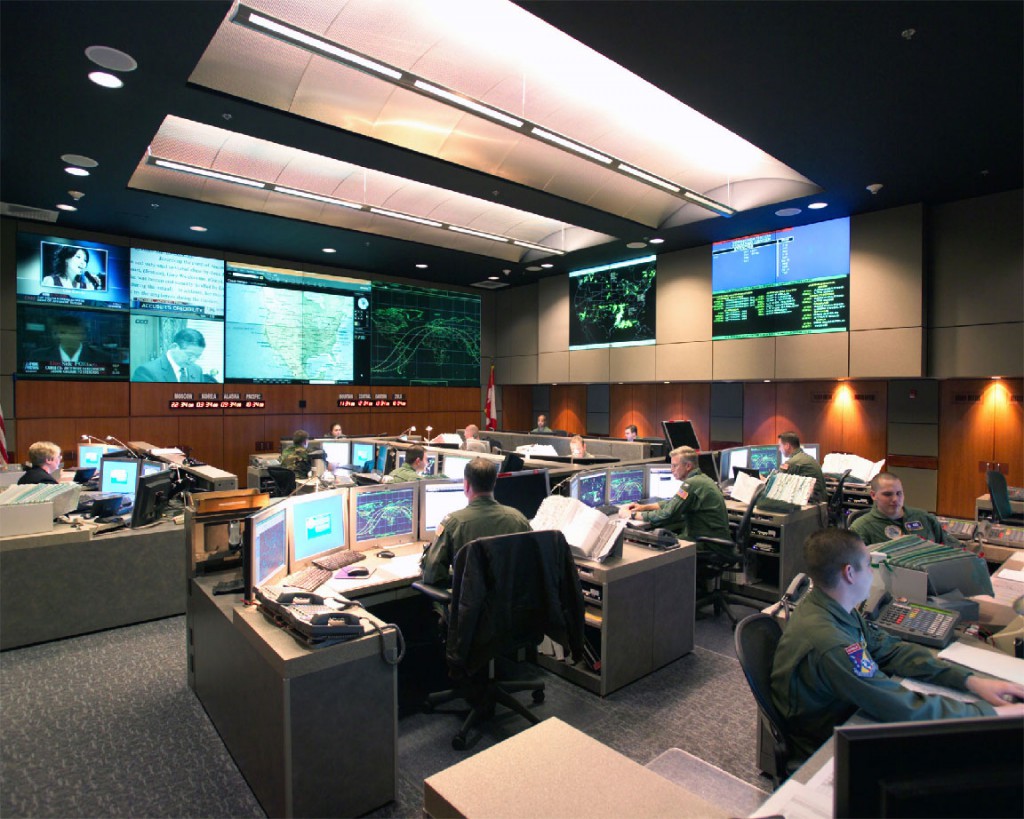 Weapon Release Authorization, which allows precise tailoring of weapon allocation and engagement doctrine (how many weapons per target, shoot early or conservatively etc.) according to individual weapons and target types.
Weapon Release Authorization, which allows precise tailoring of weapon allocation and engagement doctrine (how many weapons per target, shoot early or conservatively etc.) according to individual weapons and target types.
Mission Editor 2.0, a thoroughly revamped mission editor with lots of new options for tailoring of both friendly and enemy AI behavior depending on asset tasking.- Scenario Attachments (aka auto-bundling), which allows scenario authors to include various attachment objects (map overlays, Lua scripts etc.) to a scenario and have them executed automatically on scenario startup without manual player action.
-
- Other features & improvements included:
- Tons of UI enhancements such as discrete range rings for anti-ship and land-attack weapons, even more hotkeys, redesigned manual weapon allocation window, contact filter-out (even more map declutter) and much more.
- Lots and lots of additional Lua scripts.
- Better performance on scenarios that use zones (ie. most scens out there).
- Massive overhaul of AAW missile endgame logic; target speed matters more, and the evasion bonus must now be earned instead of automatically granted.
- Bigger effect of crew proficiency on damage control & underway repairs.
- Improvements to submarine battery recharge rates.
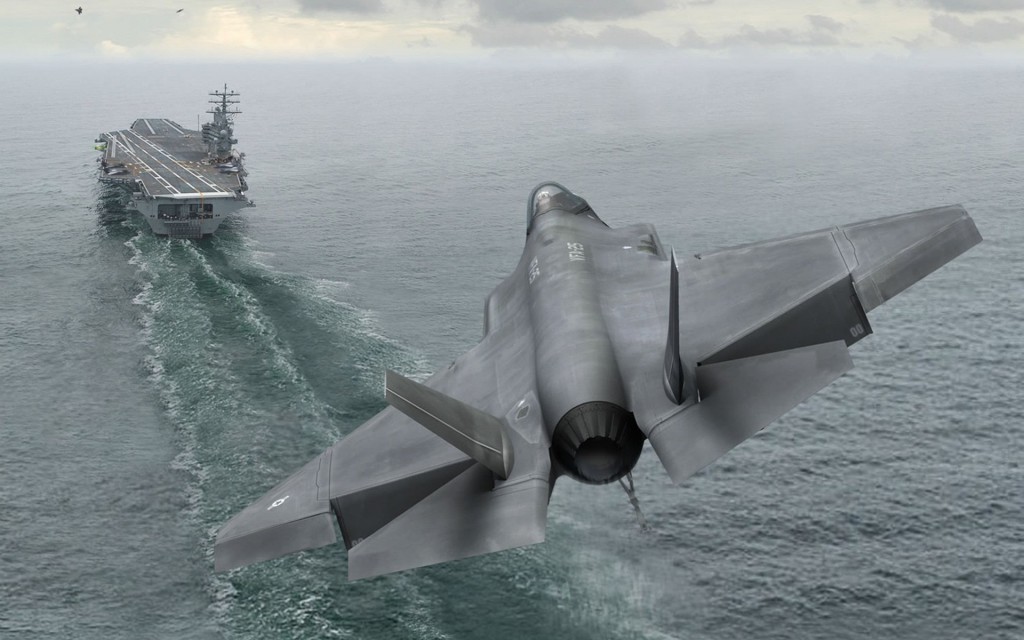 v1.08 was released on July 14, 2015. It includes:
v1.08 was released on July 14, 2015. It includes:
- New simulated weapon systems such as anti-torpedo torpedoes and related torpedo-warning sensors, new warhead types such as enhanced fragmentation (“superfrags”), new weapon types such as “Contact explosive” (for modelling sabotage or suicide bombs), a new ship type (Mobile Offshore Base (aka “Battle Island”)) etc.
- A number of user interface enhancements: Players can now observe the engagement arcs of a unit mount, permission-dependent color of targeting vectors, coastline/border fade-out on zoom (as in GE), the manual weapon allocation window can present to the player the “soft” restrictions (WRA/WCS/other doctrine settings), various tweaks to mission editor UI. etc.
- Simulation improvements: Major speed boost on large scenarios, more accurate uncertainty areas for long-range passive detections (SOSUS, ESM etc.), more reliable sub battery recharge, improved sub-captain AI on chasing after unreachable targets, snap-up/down limits for AAW guided weapons, side-firing gunships (e.g. AC-130) now maneuvering properly, more realistic UNREP transfer rates, speed-dependent aircraft IR signatures (e.g. supercruising aircraft can be picked up on IR sensors at longer ranges), tweaks to damage modelling related to light-caliber automatic weapons, realistic “no scan while painting” limitation on older mechanical radars etc.
- Various scenario editor improvements such as the “Can Auto-track civilians” side-level ability, Lua speed enhancements etc.
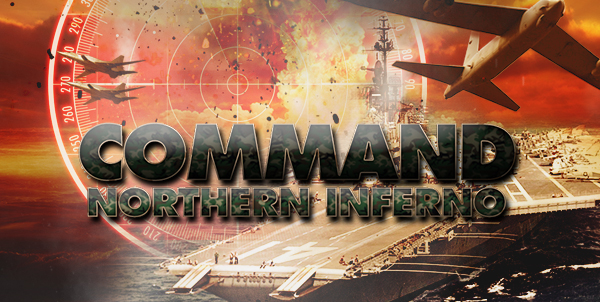 v1.09 was released on October 22, 2015. Its flagship new feature was of course the included “Northern Inferno” standalone DLC, a 15-scenario campaign forming a storyline set on 1975 in the North Atlantic.
v1.09 was released on October 22, 2015. Its flagship new feature was of course the included “Northern Inferno” standalone DLC, a 15-scenario campaign forming a storyline set on 1975 in the North Atlantic.
Other features of this release included:
-
The ability to construct campaigns just like Northern Inferno through the integrated scenario editor.
-
Nuclear EMP: Nuclear detonations now generate a proper electromagnetic pulse which can really fry sensors in the vicinity – or really far away. The magnitude and radius of the effect vary with detonation altitude and realistically affect different sensor tech generations (wonder why the Russians still like vacuum tubes?).
-
New UI/Map features like optional map placenames and the ability to display either all detected contact emissions or only those that are fire control-related.
- Massive speed improvements on large, complex scenarios.
- New Lua scripting functions like “Add Explosion” and “Change Unit Side”.
- Three new tutorial scenarios, from Mark Gellis’ popular “Uncle Mark’s Tutorials” series.
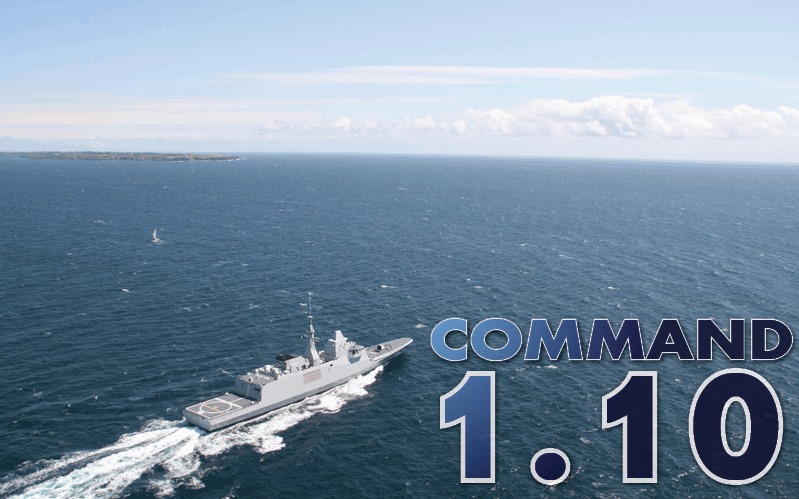 v1.10 was released on February 26, 2016. It was the first version to make use of the Steam Workshop functionality, enabling Steam users to easily upload new scenarios. Other features included:
v1.10 was released on February 26, 2016. It was the first version to make use of the Steam Workshop functionality, enabling Steam users to easily upload new scenarios. Other features included:
- Waypoints for cruise missile attacks
- Cooperative Engagement Capability (CEC / NIFC-CA)
- Improved ABM modelling
- One-click EMP strikes
- Improvements to electronic warfare modeling
- Weight-dependent aircraft kinematics
- New ScenEdit and Lua features
- Numerous gunnery-related improvements and numerous fixes, DB additions and other tweaks.
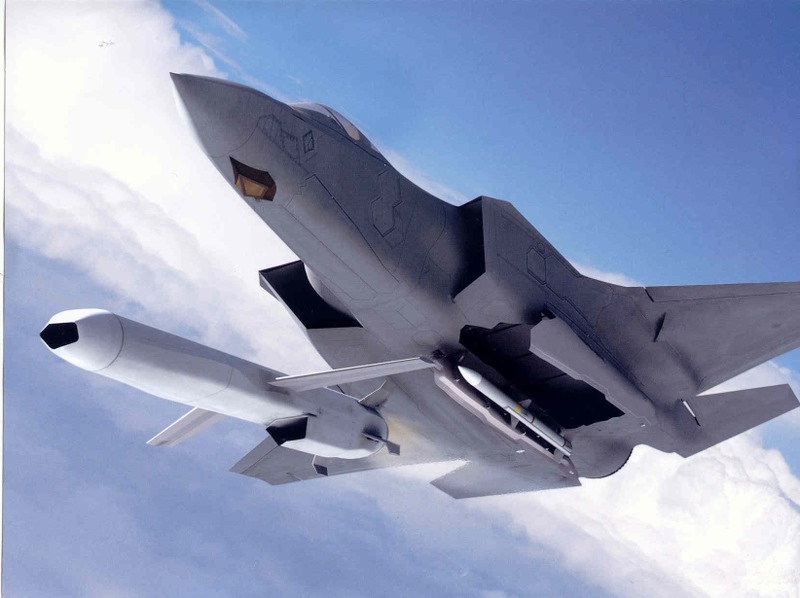 v1.11 was released on May 9, 2016. One of its marquee features is vastly expanded pier operations (ships can now rearm, refuel and repair at docks) which adds an operational/strategic layer to Command’s scope. Other new features include:
v1.11 was released on May 9, 2016. One of its marquee features is vastly expanded pier operations (ships can now rearm, refuel and repair at docks) which adds an operational/strategic layer to Command’s scope. Other new features include:
- Proper Winchester, Shotgun, Bingo, Joker and Chicken states for aircraft
- Thoroughly revised air-to-air refueling mechanics and AI
- AGL altitude settings, stores jettison and mission player feedback
- Pier Operations and revised replenishment rates
- ORBAT recon of air/naval bases
- New submarine options and massive performance gains
- “Neutron wave” effect of nuclear detonations
 v1.12 was released on May 18, 2017, and was the companion update to the Chains Of War DLC. It introduced a number of groundbreaking features, such as:
v1.12 was released on May 18, 2017, and was the companion update to the Chains Of War DLC. It introduced a number of groundbreaking features, such as:
- Communications Disruption
- Aircraft Damage
- New weapon types: Enhanced lasers, railguns and tactical EMPs
- Cargo, amphibious and airdrop operations
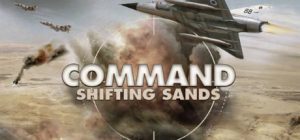 v1.13 was released on October 9, 2017, as the companion update to the Shifting Sands DLC. Some of its new features include:
v1.13 was released on October 9, 2017, as the companion update to the Shifting Sands DLC. Some of its new features include:
- Massive increase in simulation performance.
- Significant improvement on map pan/zoom speed & responsiveness.
- Tactical chaff laying is now available, allowing players to create chaff corridors to protect their offensive packages as in historical raids in WW2, the Middle East, Vietnam etc. The advantages as well as limitations of chaff corridors (and the technological reasons that gradually led to their obsolescence from the late 1970s) are faithfully modelled.
- Sprint & drift behavior is now also available for single, non-grouped units.
- AAW & ABM engagement mechanics have received a major overhaul. Various nuances have been added to the aircraft damage model, generally increasing lethality against large aircraft, conferring significant lethality bonuses to late-generation weapons (here is an example of how modern AAW weapons are scarily smart about optimizing their destructive effects), and properly rewarding hit-to-kill warheads. Numerous AAW/ABM weapons have had their max-target speed values adjusted so that they are realistically less capable at rising-speed targets (e.g. RVs), and the intercept aspect angle is also taken into account (a fully “crossing shot” can reduce the nominal PH by up to 50%).
- An all-new Lua console is introduced, offering a substantially better editing experience and functionality. The Lua API has also received myriads of improvements, additions and fixes (as always, the online reference is the best resource).
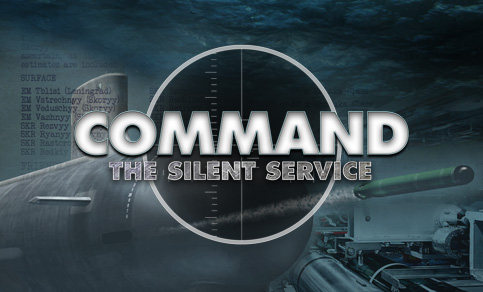 v1.14 was released on February 19, 2018, as the companion update to The Silent Service DLC. Among its new features are:
v1.14 was released on February 19, 2018, as the companion update to The Silent Service DLC. Among its new features are:
- Substantial performance boost on both user interface and simulation-core execution.
- New UI feature: Recent contact detections
- New UI feature: Mark contact position
- New UI/AI feature: “Do Not Cavitate” option
- New UI feature: Define circle areas
- New simulation feature: Weapon re-attacks
- New simulation feature: Torpedo wire breakage
- New simulation feature: Cargo pickup
- New simulation feature: Flaming datum
- Improvements in submarine damage model
- Ferry mission is now also available for ships & submarines
- New ScenEdit feature: “Chance of appearance”
- When exporting facilities using .inst files, boats berthed in these facilities are retained
- Min/Max target range for ships/subs/facilities/land-units on strike mission (e.g. “intercept and engage only targets within 200nm of your position”)
- The mission editor can now define how many aircraft in a patrol will investigate & engage contacts, as well as wingmen behavior. This helps the AI to deal more intelligently with probes, feints, decoy attacks etc., and avoid over-allocating assets on a few targets at the expense of others.
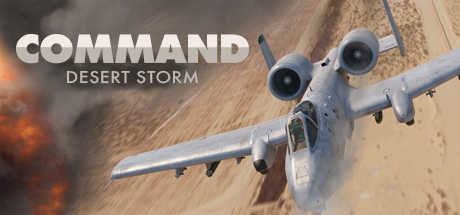 v1.15 was released on March 19, 2019, and was the companion update to the Desert Storm DLC. Among its new features are:
v1.15 was released on March 19, 2019, and was the companion update to the Desert Storm DLC. Among its new features are:
- Personal persistent map profile
- Dynamic ORBAT window
- The “Magazines” and “Weapons” window received massive speed optimizations
- Visual and IR sensors are no longer precise insta-spotters
- No more “blind AMRAAM shots”
- New doctrine setting specifically for BVR engagement behavior:
- Updated terrain data for Spratlys and other areas
- The submarine snorkelling noise penalty is now gradual
- Serious sim-performance improvements
- Numerous new Lua methods
- Content updates & additions a-plenty
In addition, each released update contains numerous bug fixes and additions to the sim databases based on user feedback.
As the documentation for the new features has not yet been merged on the original user manual, it is available separately in the form of a “Manual Addendum”.




